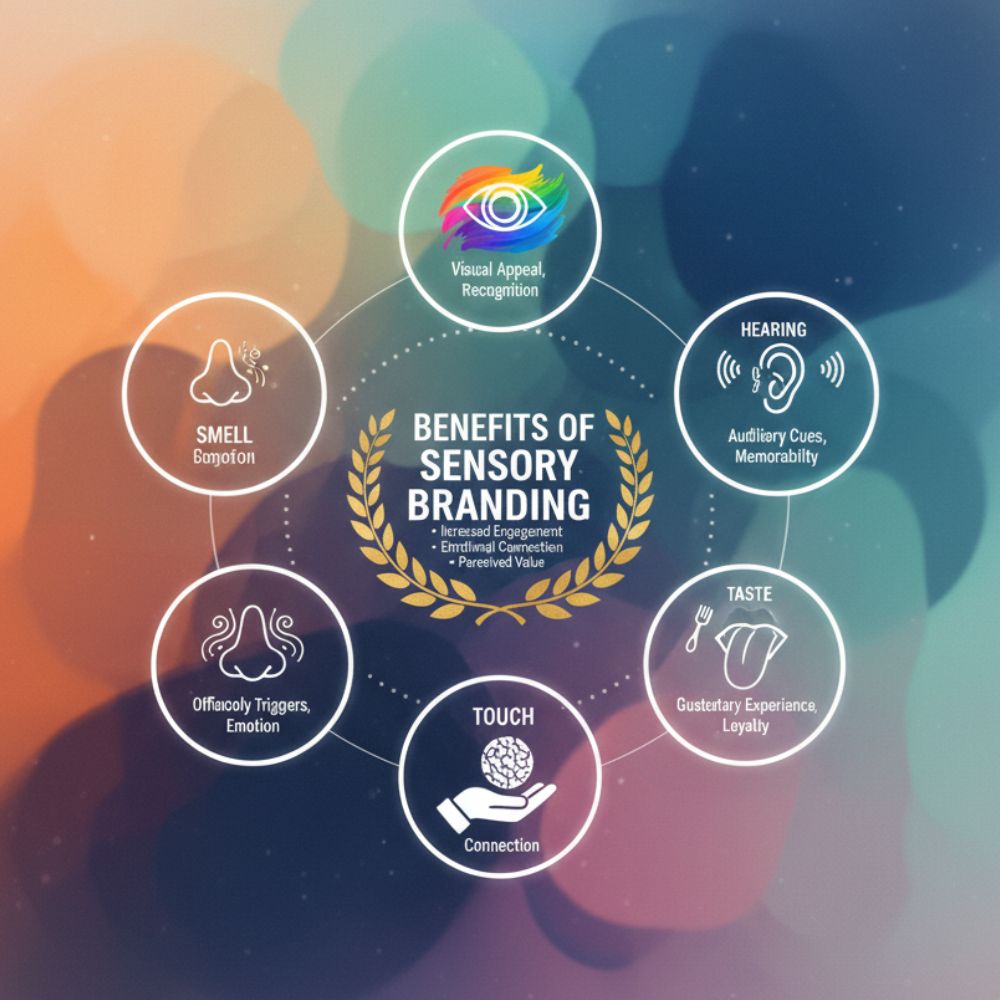Sensory Branding: Crafting Multi-Sensory Experiences That Forge Lasting Connections

Brands must find innovative ways to capture attention and create lasting impressions. Sensory branding, or multi-sensory marketing, goes beyond logos and slogans by engaging how consumers perceive and experience the world. By stimulating sight, sound, smell, touch, and taste, brands can forge stronger emotional connections and enhance brand recall.
This approach transforms marketing from passive observation into immersive brand experiences, encouraging customers to feel, hear, smell, and even taste your brand story. Sensory cues not only make your brand memorable but also influence consumer behavior and loyalty on a subconscious level.
This post explores the science behind sensory branding, practical strategies, and real-world examples, offering a roadmap to create multi-sensory experiences that resonate and stick.
What is Sensory Branding?
Sensory branding is the practice of using one or more of the five senses to enhance a consumer’s perception of a brand. While traditional marketing focuses heavily on visuals and language, sensory branding expands the toolkit to include aromas, sounds, textures, and even flavors. By engaging multiple senses simultaneously, brands can forge deeper emotional connections, reinforce brand identity, and drive recall. This holistic approach recognizes that memories and emotions are closely tied to sensory experiences, making it a powerful way to differentiate yourself in a noisy market.
Benefits of Sensory Branding

When executed thoughtfully, sensory branding offers numerous advantages. First, it improves brand recall and recognition by creating unique stimulus associations. Second, it heightens emotional engagement, as sensory cues often trigger subconscious responses linked to mood and memory. Third, it drives customer loyalty and advocacy by crafting memorable experiences that keep people talking and returning. Finally, a multi-sensory strategy can align closely with a brand’s values, reinforcing attributes like luxury, sustainability, warmth, or innovation in a way that words alone cannot communicate.
Engaging the Sense of Sight
Visual elements are the foundation of any brand strategy. Colors, typography, imagery, and product design affect consumers’ perceptions of your identity. To leverage sight effectively, start by defining a consistent color palette that reflects your brand personality. Warm tones might communicate friendliness, while cool hues suggest professionalism or calmness. Typography and spatial design influence readability and mood, whether you’re creating a website, packaging, or physical environment. Incorporating eye-catching installations or dynamic displays in retail spaces can elevate visual impact and draw attention to key messages.
Leveraging Sound for Brand Recognition
Audio or sonic branding uses music, jingles, voiceovers, and sound logos to reinforce brand identity. The human brain processes audio cues quickly and can form lasting connections between a tune and a product. Think of iconic jingles that stick in your head or the brief sound that plays when you start a smartphone. Work with sound designers to develop melodies and effects that align with your brand’s emotional tone to craft a compelling auditory identity. Integrate these elements into digital ads, hold music, point-of-sale systems, and social media content to create a cohesive sonic landscape.
Scents That Strengthen Brand Recall
Olfactory branding taps into the powerful connection between scent, memory, and emotion. Studies show that people can remember smells with up to 65 percent accuracy after a year, compared to just 50 percent for visual cues. Brands can use custom fragrances in retail stores, hotel lobbies, or product packaging to evoke specific feelings—fresh citrus for energy, vanilla for comfort, or pine for a sense of calm. Collaborate with fragrance experts to create signature scents that reflect your brand values. Consider diffusing them strategically throughout physical spaces or offering scented samples as part of multi-sensory campaigns.
Touch: The Power of Texture
Tactile experiences reinforce brand quality and foster a sensory connection beyond sight. Whether it’s the weight of a smartphone, the softness of a fabric label, or the finish on packaging materials, texture communicates value and attention to detail. When designing products and marketing materials, choose surfaces that align with your brand message—matte finishes for understated elegance, embossed details for a premium feel, or recycled materials for an eco-friendly promise. Providing in-store touch stations or sending tactile direct-mail pieces can reinforce these sensory cues and leave a lasting impression.
The Role of Taste in Brand Experiences
Though less common, taste can be a powerful tool for specific industries, from food and beverage to hospitality. Offering samples, limited-edition flavors, or taste-driven events allows customers to experience your brand in a direct, memorable way. Pairing unique flavors with strong visual or olfactory branding can create a signature experience that visitors recall long after leaving. Even product collaborations with local artisans or chefs can reinforce community ties and highlight brand values like quality, craftsmanship, or innovation through the language of flavor.
Real-World Examples of Sensory Branding
Many leading brands have successfully implemented sensory strategies to deepen engagement. For example, Apple uses minimalist design and high-quality materials to evoke sophistication, while its product startup chime signals reliability. Abercrombie & Fitch became famous for its store scent, creating an instantly recognizable atmosphere. Starbucks offers comfortable seating, ambient music, and signature coffee aromas to craft a cozy environment. Meanwhile, Samsung has experimented with texture in its packaging to reinforce a premium positioning. These examples illustrate how diverse sensory elements can work together to strengthen brand identity at multiple touchpoints.
Implementing a Multi-Sensory Strategy

To integrate sensory branding into your marketing efforts, follow these key steps:
- Conduct a sensory audit. Map out existing touchpoints and assess which senses are currently engaged.
- Align with brand identity. Choose sensory cues that reflect your core values and personality.
- Collaborate with experts. Work with designers, sound engineers, and perfumers to develop cohesive stimuli.
- Pilot and iterate. Test your multi-sensory concepts in controlled environments and gather feedback.
- Integrate across channels. Ensure consistency in physical spaces, digital platforms, packaging, and events.
- Train your team. Educate employees on the importance of sensory cues and proper implementation.
Following these steps, you can create a unified sensory experience that reinforces your brand message at every customer interaction.
Measuring the Impact of Sensory Branding
Quantifying sensory branding requires a mix of qualitative and quantitative methods. Customer surveys and focus groups can reveal how sensory elements influence perception and recall. Neuromarketing tools like EEG and eye-tracking offer insights into emotional responses. Sales data, store dwell time, social media engagement, and repeat purchase rates provide hard metrics for effectiveness. To gauge ROI, compare performance before and after implementing sensory elements, and continuously refine your approach based on customer feedback and behavioral data.
Learn More: Neuromarketing in Branding
Challenges and Best Practices
While sensory branding offers significant benefits, it also presents challenges. Overstimulating or mismatched cues can confuse consumers or dilute your message. Cultural differences may affect how scents or sounds are perceived, so consider local preferences when expanding globally. High-quality sensory elements often require investment in specialized partners and equipment. To navigate these challenges, start small with pilot tests, ensure all cues align with your brand story, and maintain consistency across all touchpoints—document guidelines for sensory usage and regularly audit experiences to keep your strategy on track.
Dig Deeper: Sensory Branding: Engaging All Five Senses to Create Unforgettable Brand Experiences
Conclusion
Sensory branding unlocks a deeper level of engagement by appealing to the multi-faceted way people experience the world. By thoughtfully integrating sight, sound, smell, touch, and taste into your brand strategy, you can create memorable interactions that foster loyalty and drive long-term value. Whether launching a new product or revitalizing an existing brand, a multi-sensory approach helps you stand out in a crowded market. Embrace the power of the senses, and you’ll build emotional connections far beyond the first glance.






